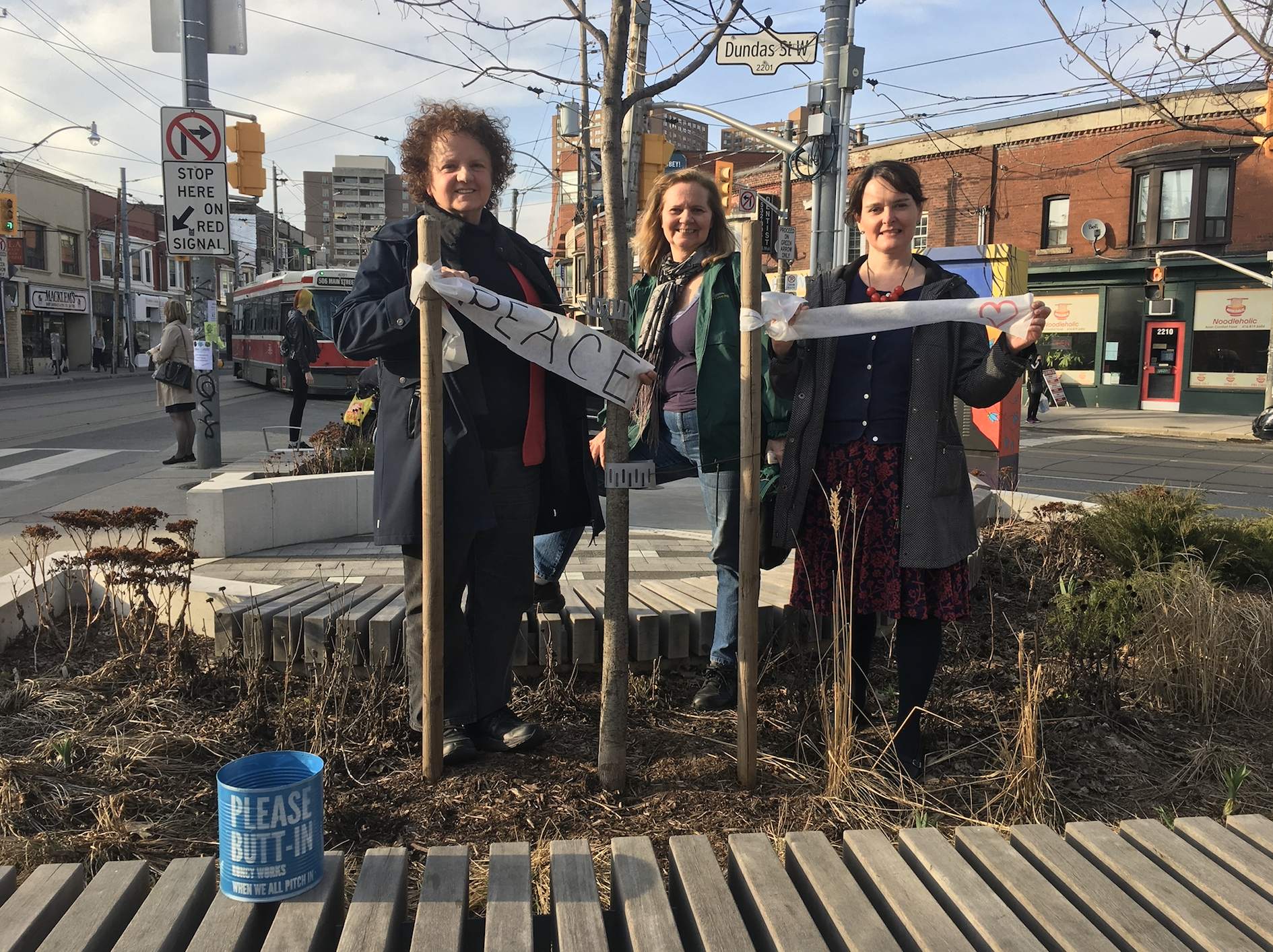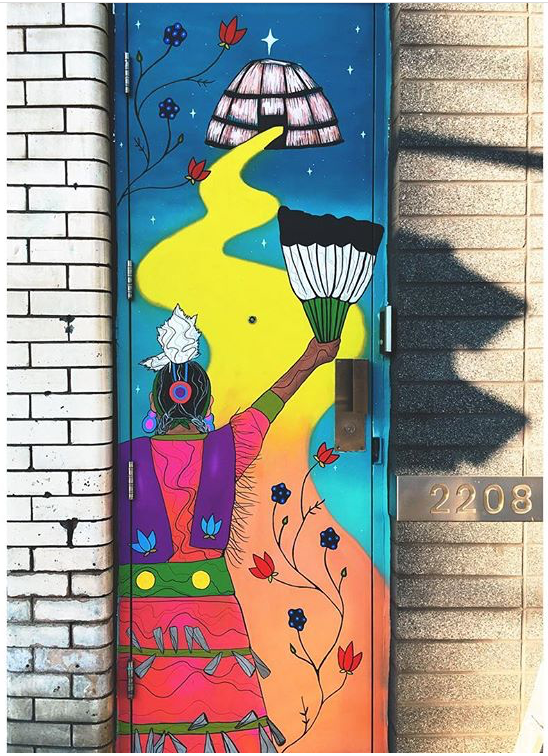In the midst of an old neighbourhood in Toronto, a tiny pocket of plants, arts and a footpath makes the scene magical at the intersection. It's an oasis surrounded by concrete space. This little piece of greenery is Dundas Roncesvalles Peace Garden. As the name suggests, this is more than a garden. A woman's dedication to promote peace, protect the environment and care for Indigenous rights developed to be the garden that connects the community together in a fun, caring and healing way. I often decide to walk, rather than drive or take the streetcar, thanks to the peace garden. Having coffee while sitting on the benches is the mood booster I need to keep me going. Kids with their tiny scooters add to the beauty of the simple, but yet, symbolic garden.

A local has an idea
The garden is maintained by collaborative efforts of volunteers. Abby Bushby, a cheerful woman, who throughout conversations doesn't forget to mention all those who have helped her to make this happen. She is the chair of Friends of the Dundas Roncesvalles Peace Garden. As with many people I met, seeing the barren spot at the intersection bothered Abby. People walked past it as fast as they could and it was an uninviting place. She came up with an idea to fill the bare patch with a garden. "People need trees along the streets. It makes you want to walk instead of driving a car," Abby says. Prior to the garden, it was arid cold in the winter and hot in the summer. Abby was bothered by how uninviting the place looked. In addition to that, she was and is still fascinated by the place's history. The intersection is one of Toronto's oldest-- the street origins as an indigenous trail that was prominent during the Battle of York (present-day Toronto) in 1812. But this rich history was barely acknowledged. Now, in addition offering a nice place filled with beautiful plants, the garden celebrates Toronto's history. The moment I first stepped in the garden, I found a map explaining the history of the place.
Read This Next: 11 Reasons Why You Should Be Planting Trees

Photo supplied by Yusur Al-Bahrani of Abby Bushby, Carla Agnesi and Maria Kolos.
Celebrating the city's history through art
The symbolic arts tell the story and history of Toronto—and voices that are often otherwise unheard. Monique Bedard, known as Aura, and her sister Nancy King, known as Chief Lady Bird, are two artists who creatively and beautifully painted the utility boxes. They aren't sisters by blood, but the bond between the two women artists is just as strong. Being both Indigenous and a woman added totally different dimensions to the painting, as men often dominate the street art world. "It's empowering to reclaim those spaces," says Aura. The dancer in the painting walks the path, the warriors walked. The other, across the road, dances back to back. They represent healing and to the women artists I met, surviving is healing. This is the first Indigenous artwork on a traffic signal box in Toronto. Aura and Chief Lady Bird make sure that they "do everything in a loving healing way." "Our voices are always there, but this makes them more present," says Aura.
Despite having the idea years before, Abby only got the garden together in 2016. The process of getting this together was years of friendship— she made sure to consult with the Indigenous communities who are one of the founding pillars in the creation of this haven of peace. As I walk through the garden, the surrounding arts and the engravings on the ground fascinate me. The engraved artwork on the ground is the Peace Path: the first permanent joint community arts project between a Toronto community and the Mississaugas of the New Credit First Nation.
Getting local government on board
I met City Councillor Gord Perks, a leading environmental advocate and an Adjacent Professor with the University of Toronto's Environmental Studies Department who has been supportive of the project since the beginning. "Wherever we can break through the surface of all the concrete and show living things, we can help to remind people that we are of and part of the living world," Perks,, says. "We can't succeed in just built environment." Although the project received financial support from the City of Toronto, the community and local businesses are responsible for its future sustainability. Looking at the current status of the garden and volunteers' dedication, it would seem it has many years ahead of it.

Supporting native plants and feeding the community
The Peace Garden is now home to a variety of local native species of plants and trees. As I am writing, Three Sisters are going to flourish and find their way in the garden's soil. Three Sisters are native plants— squash, corn and beans. Those in specific, help people being sustained on a plant based diet: another way to help take care of the planet around us, raising awareness of the importance of the environment and growing local food. Abby is excited about it. The plants are chosen in consultation with the local and indigenous communities. In the summer, I might need to make some changes in my routine: learn how to make the Three Sisters stew, hoping that this will be added to my Peace Garden rituals in addition to sipping coffee while sitting on the bench. Aby is thrilled to grow the plants, and like the rest of the garden, the community will take care of them. The three plants together. They grow to support and sustain each other, just like inseparable sisters, and hence, are named Three Sisters.
Peace, Indigenous rights and environment are three integrated elements of the garden. When maintained by the community, it means that those issues are crucial to people. In the bigger picture, it seems like a small initiative. But it's not. If communities adapt this project across the city, country and the world, then those important issues are going to be the priority.
Yusur Al Bahrani is a Canadian journalist who has written for several publications focusing on foreign affairs and women's rights. Her current focus on environmental issues is informed by a journalism background and years of experience working for non-profit organizations. She's also currently a national board member at Canadian Voice of Women for Peace (VOW)
Read this next: How To Grow A Garden In A Small Space
Header Image: Shutterstock
We're in a climate emergency and it's going to take all of us to get out of it. That's why 1 Million Women is building a global community of women committed to fighting climate change with our daily actions. To join the (free) movement just click the button below!
